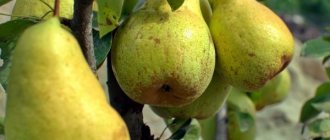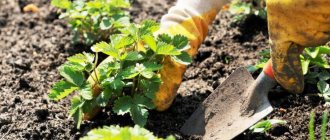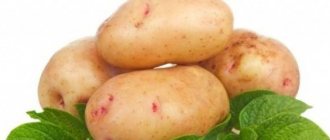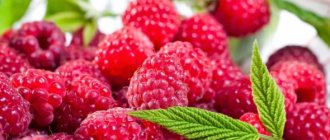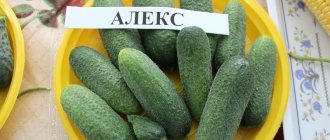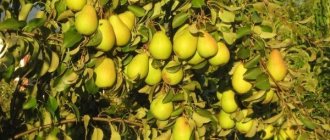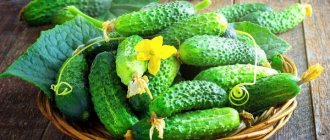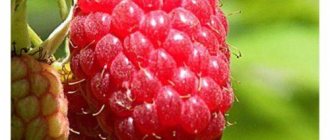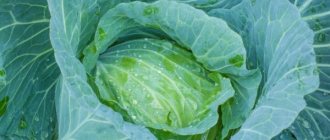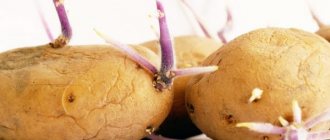Autumn Yakovleva pear.
Description of the variety
The Autumn Yakovleva pear, as the name suggests, ripens in the autumn. The tree is a decent size, fast growing and bushy. The fruits are medium-sized, of very high taste.
Characteristics of wood
The fruit culture of Memory of Yakovlev reaches a height of 7 meters. The crown is rounded and drooping. High shoot-forming ability guarantees a regular harvest, but at the same time contributes to a strong thickening of the crown.
Description of fruits
Autumn Yakovleva.
The fruits are medium in size, but there are also large specimens, weighing from 180 to 230 grams. The skin is yellow-green, with a slight blush. The shape is regular, broadly pear-shaped.
The taste of the fruits of the Osennyaya Yakovleva variety is very high. Tasting score 4.8 points. The pulp is juicy, sweet, melting and slightly oily.
Pear "Hera"
This variety is medium in height, its crown is small, narrow-pyramidal. Fruits are formed on both annual and perennial branches. The plant tolerates frost well and produces a magnificent harvest. The foliage has an oval, slightly curved shape, and is colored in a rich dark green color. The shoots are quite thick, straight, with a small number of lentils. The buds are medium-sized, round, tightly adjacent to the trunk.
Fruit:
- enlarged, weighing on average 230 grams;
- have the correct shape characteristic of pears;
- their skin is rough, of medium thickness, a little dry;
- painted green, with a reddish outer tint and a rusty mesh;
- the pulp is cream-colored, fine-grained, has a weak aroma and contains a lot of juice;
- The taste of pears of this variety is sweet and sour;
- are stored for up to six months.
Varietal features
Harvesting begins towards the end of September, and active fruiting of plants begins 4 years after planting. Remarkably withstands severe frosts up to 39 °C.
To obtain a full harvest, other varieties of pears must also grow on the site, since “Hera” has low self-fertility. If it is not possible to grow several varieties, it is necessary to make several grafts from other varieties on each tree. In this case, you can do without pollinators.
Planting and care
Trees are planted in the fall, in advance, before the onset of frost. When planting, it is important to maintain a distance of at least 3 meters between pears and other trees or buildings. Poor survival rate of plants is noted due to the characteristics of the root system.
Landing is carried out according to the following algorithm:
- a hole is dug a meter deep and 80 centimeters in diameter;
- humus, potassium sulfate, sand and peat are added to it;
- fertilizers are poured into two buckets of water, and the hole is left for a week;
- At the end of the period, the tree is planted.
You need to water the pear regularly:
- first watering - immediately after planting;
- in the first year - before the tree takes root;
- subsequently - during drought and three times in the summer: before the flowers appear, during the appearance of fruit ovaries and in October.
The plant needs pruning - thinning (removing thick branches that interfere with the sun's rays), shortening the top (so that the plant does not grow too much), removing diseased, old and branches growing at right angles. The cut must be treated with a specialized garden varnish to prevent loss of juice and death of the pear. The cutting itself is carried out near the trunk, so that no stumps remain.
Mature trees do not need shelter for the winter, but young trees just need to be covered with spruce branches and fallen snow. Trees are susceptible to diseases and pests, so timely treatment should be carried out in spring, summer and before wintering.
Reviews
The Autumn Yakovleva pear is very tasty, but for our area it is very afraid of the cold. She often suffered from cold weather and suffered from scab almost every year. I had to get rid of it, although it’s a shame.
Valentine
Kaluga region
I have Osennyaya Yakovleva growing on my plot. I won’t hide that there are a lot of problems with her, she’s capricious. But the delicious fruits are worth it. Although I was advised to change to new varieties, less capricious, I am very attached to it.
Tamara
Rostov region
This pear was recommended to me as very tasty. It has been growing on the site for 10 years. She doesn’t freeze, but she periodically gets scab. But the fruits are very juicy and sweet.
Andrey Vitalievich
Crimea
Advantages and disadvantages
Key benefits:
- frost resistance. The pear can withstand frost down to -28 degrees. Important! But to prevent the tree from being damaged, it is still better to wrap it before the onset of cold weather;
- resistance to dry periods;
- has very tasty and healthy fruits, which include a large amount of vitamins:
- provides a large amount of harvest every year;
- Fruits can be stored for up to 2 months.
Key disadvantages:
- easily affected by scab;
- needs annual crown pruning;
- the tree itself grows to large sizes.
Landing
The Autumn Yakovleva pear is undemanding in terms of soil composition, but it can only show maximum productivity on fertile soil. She also does not like stagnant moisture, close proximity to groundwater and cold winds. Detailed instructions and detailed technology for planting seedlings of this variety can be found in the articles selected below.
How to plant a pear tree correctly
At what distance to plant pears?
How to choose pear seedlings
How to replant a pear
Care
The variety requires special care. To maintain the health and strong immunity of the plant, it is necessary to water and feed it in a timely manner. An important feature of agricultural technology is the correct pruning and shaping of the crown, which is prone to thickening. More materials on the topic of growing the Autumn Yakovleva pear can be found by clicking on the links below.
How to care for a pear Pruning a pear Pruning a columnar pear Treating a pear from diseases and pests Feeding a pear How to water a pear
A brief excursion into history
Yakovlevskaya pear: photo of variety
At the end of the nineties of the 20th century, scientist-breeders of the State Scientific Institution All-Russian Research Institute of Genetics and Selection of Fruit Plants named after Michurin crossed the pear varieties “Tolgarskaya Krasavitsa” and “Daughter of the Dawn”, thus creating a whole group of hybrids: “Nika”, “Chudesnitsa”, “Fairy”, "Yakovlevskaya". After a lot of experimentation, all these varieties were awarded the status of different pear varieties with slightly similar, but still separate characteristics.
Yakovlevskaya pear was bred by such breeders as: Yakovlev S.P., Chivilev V.V., Savelyev N.I., Gribanovsky A.P. Since 2002, this variety has been officially listed in the state register and is recommended for cultivation in Belgorod, Voronezh, Kursk, Lipetsk, Oryol, Tambov regions.
As gardeners note, the Yakovlevskaya pear variety has adapted perfectly and is pleased with rich harvests even further north, for example, in the Moscow region, in the Yaroslavl and Leningrad regions.
Diseases and pests
The variety is not resistant to diseases and pests. To eliminate the risk of infection, preventive maintenance should be carried out regularly, including proper spraying several times a season. When diseases appear on a tree, you need to immediately proceed to treatment. The rules for carrying out preventive measures and protecting Autumn Yakovlev from pests and diseases can be found in the selection of articles listed below
Dangerous Pear Pests
Pears often suffer from pests, they affect the leaves, bark and fruits.
In this article, we have selected 11 of the most harmful insects that harm pear trees, and also ways to destroy them.
Diseases of pear trees
To get what they cherish, gardeners have to work hard, and the reason for this is pear diseases.
Read about 19 common pear diseases and how to combat them.
Features of growing pears Autumn Yakovleva
When cultivating the variety described, in general, conventional pear farming techniques are used. There are nuances that need to be taken into account, but there are very few of them.
Landing
The gardener will have less risk if he plants a pear tree in the spring. In the middle zone, during autumn planting, an unrooted seedling may freeze in the winter. The growing conditions are usual for pears: a sunny place protected from drafts, air- and water-permeable fertile soil (loam, chernozem) with an acidity of pH 5.5–6, the absence of groundwater lying above 2 m.
Powerful tall trees need sufficient area for full development, so in the recommended placement scheme (4–4.5x5–6 m) you should not reduce the distance between them - this is the main thing to consider when planting. Organic (humus or compost) and mineral (potassium and phosphorus) fertilizers are added to the planting pits. The process of planting a seedling itself does not have any special features.
When planting the Autumn Yakovleva pear, you need to take into account the significant size of its crown and observe the recommended distance between trees
Crown formation and other types of pruning
The standard formation for tall trees is sparsely layered. A one-year-old seedling is shortened to 70 cm. In the next season, the first tier of 3–4 shoots is formed, which are left above 45–50 cm (the height of the trunk). Over the course of another 2 years, 2–3 frame branches of the second tier are laid, placing them 35–40 cm from the top branch of the first tier. If necessary, form 1–2 branches of the third tier. After 5 years, a crown consisting of 6–8 frame branches is obtained.
Don’t forget about other types of pruning:
- sanitary (removal of diseased, dried and broken branches);
- regulating (thinning);
- supporting (shortening, stimulating fruiting).
The last type of pruning can be carried out by shortening young shoots by 5–10 cm (chasing) - this is the simplest method. A more complex option is the formation of replacement shoots to replace fruiting formations (as when pruning a grapevine).
The option of maintenance pruning of pears by forming replacement shoots to replace fruiting formations is more suitable for experienced gardeners
Video: diagram of the sparse-tiered formation of a fruit tree
Watering and fertilizing
The variety is resistant to drought, so you can limit yourself to a standard watering schedule: before and after flowering, during the period of fruit filling and in the fall (moisture-charging watering). Watering should be generous enough so that moisture penetrates the soil to a depth of at least 30–35 cm.
Within 3–4 years, young trees will use the nutrients added during planting, then they will need additional feeding. They are carried out at the usual time for pears:
- In the spring (before flowering begins), nitrogen fertilizers are applied.
- After flowering, during the period of growth and fruiting, plants are given potassium and phosphorus. Also during this period, liquid organic infusions of cow manure, chicken droppings or mowed grass will be useful.
- During autumn digging, superphosphate is added.
Every 2–3 years in the spring, organic matter (humus, compost, peat) is added along with digging.
Diseases and pests
To minimize problems associated with diseases and pests or avoid them altogether, the following preventive measures must be carried out in a timely manner:
- collect and destroy plant debris showing signs of damage by diseases and pests;
- in the fall, dig up the soil to a depth of 20–25 cm, turning over the layers to raise pests and pathogens to the top;
- treat damage to the bark by stripping it and treating it with fungicides;
- avoid dense plantings and thin out the crowns in a timely manner;
- in the pre-winter period, whiten trunks and frame branches with a solution of slaked lime and copper sulfate;
- in the spring, install fishing belts on the trunks;
- spray with fungicides and insecticides in accordance with the schedule of preventive treatments;
- provide plants with the necessary care to increase their tolerance to adverse factors.
The risk of damage to the Autumn pear by Yakovlev scab is very high, especially during the years of its mass distribution. Its development is favored by high humidity combined with cool weather. The disease is caused by a fungus that affects various vegetative organs of the pear. The signs of scab are as follows:
- large, compacted dark green spots form on the leaves, which subsequently become brownish-brown;
- the bark on young shoots cracks and swells, their growth slows down;
- dark, suberized spots with cracks appear on the fruits, through which pathogenic microorganisms penetrate, causing the pears to rot.
In case of severe damage by the disease in early spring, trees are sprayed with 3% Bordeaux mixture, and the same treatment is repeated in the fall. During the growing season (before flowering and 2-3 times after it with an interval of 10-12 days), fungicides (Horus, Skor and others) are used.
Regarding pests, we can recommend that the gardener carry out thorough prevention of their occurrence: when signs of damage become visible, it is too late to fight harmful insects. Below is a list of the most common pear pests:
- pear moth;
- pear flower beetle (weevil);
- pear leafworm aphid;
- winter moth;
- pear sucker.
Photo gallery: signs of scab disease on various parts of the pear
When infected with scab, the leaves become covered with brown spots and fall off prematurely. Scab also affects young shoots, the bark on them cracks and swells. On pear fruits, scab appears in the form of dark spots, in place of which the flesh becomes coarse and cracks
Photo gallery: pear pests
The pear moth is a common pest of pears. The pear weevil attacks pear trees. The leaf roller aphid also harms pears. Caterpillars of the winter moth infect pear leaves. Larvae of the pear honeymoth feed on tree sap.
1 Description of the variety
An early variety of pears. Developed by a group of scientists from Russia under the leadership of P. N. Yakovlev as a result of crossing the Tema and Olivier de Serre varieties. The resulting variety inherited the best characteristics from each specimen.
The encyclopedia provides a detailed description and main characteristics of the hybrid. The trees are compact, 1.5-2 meters high. The crown is spherical, sparse. The leaves are small, dark green in color. The variety does not require pollination. The proximity of Avgustovskaya and Lada pears will help increase productivity.
A young pear bears fruit from the age of 3 to 5 years. At 7-8 years it reaches its peak yield. The fruits are small, shiny, smooth, yellow with golden sides, ripen on horizontal branches in September. Their weight is 120-150 g. The pulp is white, juicy, sweet, without astringency. Thanks to the long, strong stalk, they stay on the branches for a long time. They are consumed fresh and prepared into compotes, preserves and jams.
The tree is frost-resistant and tolerates temperature changes. Resistant to scab (a fungal disease that affects the plant).
The variety has some disadvantages. The fruits of old trees become uneven, lumpy, and there are hard grains in their pulp. The plant does not tolerate drought well and needs abundant watering. The variety is often confused with other autumn pears - “Yakovlev’s favorite”, “autumn Yakovlev”. There are significant differences between them.
We recommend

